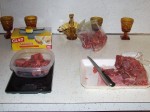“Enhanced” meats; more common than you might think.
 One of my most common cautions to prey model feeders and grinders who home-prepare their cats’ foods is to be very careful the meats they purchase are not “enhanced.”
One of my most common cautions to prey model feeders and grinders who home-prepare their cats’ foods is to be very careful the meats they purchase are not “enhanced.”
Adjectives like ‘injected’, ‘added flavor’, ‘more tender’, ‘seasoned’, and ‘juicier’ are all indications that a broth or some type of solution – most often sodium and water – has been added to the meat. Shockingly, poultry and meat products can be up to 40% solution by weight; a huge percentage when considering these products are sold by the pound.
Even careful reading of the fine print on a package may not help us identify which meats are enhanced and which are not, however, as companies are not currently required to divulge this information if they don’t wish to. Naturally, many do not; plumping their bottom line while doing a disservice to consumers from both a pricing and a health perspective.
According to the US Department of Agriculture (USDA), 30% of the poultry, 15% of the beef and 90% of the pork sold in the US contains an added solution. The Center for Science in the Public Interest states that sodium and water-injected poultry and meats can have more than five times as much sodium as occurs naturally in those foods!
These solution-injected meats are incredibly unhealthy for us and our cats and can wreak havoc upon feline physiology. Cats who eat them can suffer vomiting, diarrhea, heavy panting, increased thirst and urination, incontinence, itching, hives, a rash or worse.
Last July, the USDA finally decided the public has a right to this information, however, the legislation is unlikely to be effective until 2014 or later. So how do we protect ourselves and our pets in the meantime?
A review of the USDA Nutrient Database for non-enhanced sodium values on a few of the most popular meat products provides us with the following information:
– Beef, composite of trimmed retail cuts, separable lean and fat, trimmed to 1/8″ fat, all grades, cooked, 4 ounces = 71 mgs
– Pork, fresh, composite of trimmed retail cuts (loin and shoulder blade), separable lean and fat, cooked, 4 ounces = 47 mgs
– Lamb, domestic, composite of trimmed retail cuts, separable lean and fat, trimmed to 1/4″ fat, choice, cooked, 4 ounces = 82 mgs
– Chicken, broilers or fryers, breast, meat only, cooked, roasted, 4 ounces = 84 mgs
Based on this data, if the per serving sodium content of a meat exceeds 100 mgs, it’s likely you’re paying for water weight and extra salt and other spices with your meat. Per serving sodium amounts less than that should be safe for you and all your family members, furred or otherwise.
Bottom line, check those labels carefully and consistently.
If you enjoyed this post or found it informative, please “Like” it, “Tweet” it, or share it using any of the buttons below. And don’t forget to check out our FB page, join the discussions in our awesome FB group and follow us on Twitter!


Comments
“Enhanced” meats; more common than you might think. — No Comments